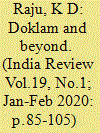|
|
|
Sort Order |
|
|
|
Items / Page
|
|
|
|
|
|
|
| Srl | Item |
| 1 |
ID:
171225


|
|
|
|
|
| Summary/Abstract |
The end of dominant party rule is a fraught moment for political-bureaucratic relations in developing countries, with critical implications for public service delivery. This article examines political change in the state of West Bengal in eastern India, where a coalition of left-wing parties was deposed from power in 2011 by a populist opposition after 34 years of uninterrupted rule. The “change” party in West Bengal has not only avoided bureaucratic instability, public officials were successfully mobilized to increase the flow of public services. I argue that this anomaly can be explained by incorporating two variables whose effects have been under-theorized in existing research – the nature of the political mandate against the erstwhile dominant party and the organizational structures of the alternation party. More specifically, I argue that the electoral disintegration of the Left and the populist orientation of the new ruling party were crucial in producing a framework for cooperative political-bureaucratic relations. In the long run, however, as the frequently insufficient quality of these services indicate, only a programmatic mode of party politics can deliver lasting citizen satisfaction.
|
|
|
|
|
|
|
|
|
|
|
|
|
|
|
|
| 2 |
ID:
171228


|
|
|
|
|
| Summary/Abstract |
Sovereignty over territory is the founding principle of international legal order and essential for the implementation of the sovereign rights of a State. Territorial disputes become commonplace among countries, mainly when bilateral agreements do not explicitly demarcate them. India and China are two Asian giants when it comes to population and economy. The recent cross-border tension between India and China has at its vortex the issue of the Doklam plateau region which shares borders with three countries namely India, Bhutan, and China and is popularly known as the “Tri-Junction.”
The present article re-visits the history of the Indo-China border dispute and tries to explain the legal aspects of border disputes under international law. It closely analyzes the principles applicable to these disputes and the decisions of various international institutions that are relevant. Furthermore, the article examines bilateral agreements to understand the possible violations and consequences under international law. It is argued that the peaceful co-existence between India and China must be of paramount importance to ensure Asian security and well-being. Keywords: India, China, Bhutan, Doklam, Territorial Disputes.
|
|
|
|
|
|
|
|
|
|
|
|
|
|
|
|
| 3 |
ID:
171227


|
|
|
|
|
| Summary/Abstract |
This article offers a glimpse of the representation of India in The Pakistan Times in 1950–51, in the last months of the first phase of its editorship by Faiz Ahmed Faiz. It contextualizes this reflection in a period of relative lull, marked by pacts on minorities and trade, within the post-Partition upheaval. Focusing especially on editorials, commentaries, and cartoons, it highlights the formation of views of the neighbor from the news that was being generated. The stress is on firstly, a variety of themes included – not just the “unfinished business of Partition”, secondly, a responsible review of these themes – not just a narrow-minded nationalist reading, and thirdly, an involved – if not intertwined – interpretation of both countries’ socio-economic relations, while not underplaying the differences of their regimes. Further, the article goes beyond an inter-governmental framework, as The Pakistan Times went beyond it and presents a slice of the possibilities then existing, of a progressive politics on questions of class, community, and capital. In early independent Pakistan, this was personified by Faiz and this article, while not on him nor on an extensive Saidian reflection of the “other”, tries to trace his imprint in the representation of India in the newspaper he edited and seeks to contribute to our understanding of India as constructed through Pakistani eyes.
|
|
|
|
|
|
|
|
|
|
|
|
|
|
|
|
| 4 |
ID:
171226


|
|
|
|
|
| Summary/Abstract |
Geopolitical interests and concerns motivate India’s renewed push for subregional connectivity. The evolving subregional approach aims at re-integrating India’s immediate neighborhood with the aim of protecting New Delhi’s traditional regional primacy. Historically, the Partition of the Indian subcontinent terminated a well-connected common space. Decades after its independence, India has turned toward reconnecting with its immediate neighbors clustered in subregions in the changing geopolitical context. India’s subregional approach has emerged as a key area of foreign policy priority. This paper attempts to map out India’s evolving subregional approach and explicates the strategic rationale behind it. Even as India has pushed to expand subregional connectivity, there are both domestic as well as external challenges. The article examines how India has been addressing some of the major hurdles underlining their policy implications. First, the conceptual underpinnings of India’s evolving subregional approach are explicated followed by an analysis of the factors driving this push. Subsequently, key subregional projects initiated by India are discussed. Finally, the challenges facing India in managing subregional initiatives are examined.
|
|
|
|
|
|
|
|
|
|
|
|
|
|
|
|
|
|
|
|
|